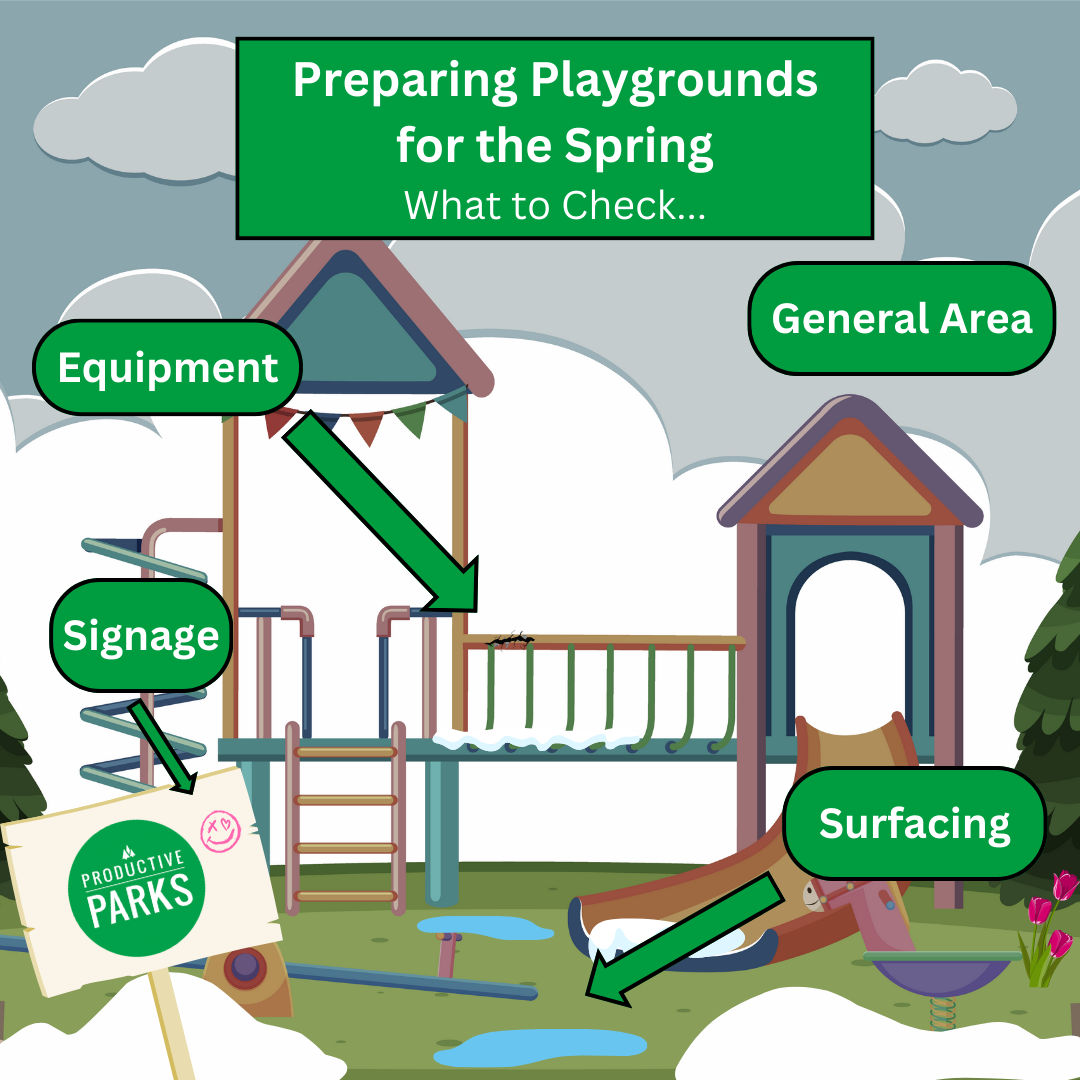
It’s time to start preparing your playgrounds for the spring--especially if your agency is in a northern climate where playgrounds don’t get much use in the winter.
As the weather gets nicer, more children and families will visit your parks and playgrounds.
One of the most significant responsibilities of park maintenance workers is ensuring playgrounds are safe, free of hazards, and ready for action. Do you have a plan to make sure your outdoor assets are prepared for the increased traffic?
In this article, learn what to look for and do to help ensure your playgrounds are safe for visitors this spring.
Playground Areas to Address in the Spring
Playground hazards can take many forms. When you understand some of the most common areas of concern, you can break down your tasks and inspections to ensure nothing gets missed.

Surfacing
Winter is hard on playground surfacing. You should check for damage or issues that could worsen during the rainy spring season.
For loose-fill surfacing, ensure no low spots, especially near areas where falls can occur. Check the surfacing by slides, climbing structures, swings, and anywhere falls are common. Make sure you follow all manufacturer's guidelines for loose-fill depth. Generally speaking, you want the depth to be at least 6 inches, but probably closer to 9 or 12.
Unitary surfaces require inspecting for cracks, low spots, wear and tear, and other damage. Use the manufacturers’ guidelines to repair and replace damaged areas so they don’t worsen with the extra rainy weather and foot traffic.
Also, check for any areas with puddles or poor drainage. Report any drainage issues and address them immediately to prevent further damage and potential hazards.
Equipment
Regular playground inspections are one of the surest ways to keep your playgrounds safe. Many parks and recreation agencies perform high-frequency and low-frequency playground inspections.
Here’s the difference:
- High-frequency playground inspections are quick checks for any obvious hazards, safety concerns, or cleanliness issues. For example, maintenance staff may conduct a weekly high-frequency inspection to check equipment, surfacing, and general conditions for any visible signs of danger or damage.
- Low-frequency playground inspections take a closer look at all the equipment and amenities to search for issues that may not be as obvious during a brief walkthrough. These inspections take longer to do and are much more detailed. They may only be conducted monthly, quarterly, or semi-annually.
It’s recommended to start the spring season with a low-frequency playground inspection. This type of inspection will alert you to any playground issues caused by the winter weather.
A low-frequency playground inspection for equipment could include checking for:
- Loose bolts, screws, nails, or other hardware.
- Splinters, breaks, or cracks in playground components.
- Corrosion, rust, or deterioration of metal parts.
- Worn or damaged chains, ropes, or cables.
- Missing or loose caps or plugs on bolts or other openings.
- Sharp edges or protruding hazards.
- Secure steps, handrails, and platforms.
- Missing rungs, steps, seats, or rails.
- Exposed concrete footers.
- Missing supports/anchors.
- Worn seats on benches and other equipment.
- Neck or head entrapment hazards.
- Potential clothing entanglement hazards.
- Functional and unobstructed accessibility features.
This is by no means an exhaustive list. While creating or amending your playground inspections, you should consult with manufacturers’ guidelines and site-specific issues that can arise at your playgrounds.
Signage
Park signs convey an essential message and impression to your visitors. Be sure they are in the best condition.
Make sure your park signs send a clear, understandable message. Verify all safety and informational signs are present, legible, and secured.
Check the conditions of the posts, lettering, sign material, fasteners, and other components. Look for any damage, graffiti, or signs of wear and tear. Consider creating a formal sign inspection to keep records of your sign conditions.
General Area
Finally, check the conditions of the area. Are there any potential hazards?
Look for things like:
- Protruding roots
- Uneven surfaces
- Broken or out-of-place edging materials
- Litter and debris
- Animal droppings
- Graffiti or vandalism
- Fallen branches or overgrown vegetation causing hazards
Basically, if it looks like it could be a hazard, remove it or report it.
Keep Records of Your Work
Document any work completed to get playgrounds ready for the spring. These records will help prove your diligence if there is an incident.
Also, make sure any issues get communicated through your park maintenance work order system. Reporting helps managers identify and prioritize hazards that require further evaluation and repair.
Other Ways to Prepare Your Parks/Playground for the Spring
Hold a playground opening event. Celebrate the start of the spring season with a fun event to get children and families out to your parks.
Promote playground safety. Have the marketing department launch a social media campaign with safety educational materials and reminders about safe play practices.
Schedule routine maintenance for the season. Take some time now to schedule and assign routine maintenance for each playground. Having a set series of scheduled tasks for each playground will help ensure the areas get monitored and routine maintenance doesn’t slip through the cracks.
The Takeaway
Be sure your playgrounds are ready for the upcoming spring and summer season by doing a thorough inspection of each of your playground areas. Remove any hazards and make note of issues that will need further attention.
Plan your inspections and routine maintenance schedules early to ensure nothing is missed or overlooked. Tasks that help keep parks safe include routine low and high-frequency inspections, cleaning, and equipment maintenance.
Preparing your playgrounds for the spring ensures a safe, fun environment for both your big and small visitors.
